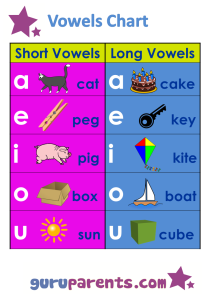Our vowels chart can help your child recognize the different sounds for each vowel.

Once your child has started sounding out words, they will soon discover there are a set of ‘rules’ surrounding vowels.
You can use this vowels chart to help explain that, in addition to their normal sound, sometimes vowels ‘say their name’ – most notably when there is an E at the end of the word (Super E!).
For instance, when sounding out the words ‘hat & hate’, ‘hop & hope’
or ‘cot & coat’, ‘boat’, ‘street’, meat’ and so on.
Our Letter Worksheets explain this in more detail for each letter.
What are Vowels?
The letters A, E, I, O and U are defined as vowels. Vowels are different to consonants in that they are pronounced with an open mouth.
A vowel can have a long sound, a short sound, or remain silent – depending on its position in the word and the letters around it.
Difference between a Long Vowel and a Short Vowel
When a vowel sounds like its name, this is called a long sound.
For example, “cake” has a long ‘a’ sound – a long vowel.
A short vowel is when a vowel do not follow this rule, and is pronouced with its phonetic sound.
For example, “cat” has a short ‘a’ sound – a short vowel.
Note: There’s no need for children to worry about the actual terms ‘long’ versus ‘short’ vowel sounds – this is adult terminology.
How to use the Vowels Chart
- Have the vowels chart handy for a child to refer to when they are reading to help them sound out words
- Focus on one side of the chart at a time (you may start with short vowels if your child is already familiar with the phonetic sound of the vowel).
- Ask your child the name of the vowel, and to identify the picture (this will help when sounding out the word).
- Help your child to sound out the word.
- Now ask your child what sound the vowel makes.
Alternatively, you could focus on one vowel at a time and compare the two different sounds that each vowel makes.
Letter Resources
Letter Worksheets – There are various worksheets that cover various rules and sounds for each letter of the alphabet in our letter worksheets.
Beginning Sounds Worksheets – There are twenty worksheets you can use to cover a range of letter blends and digraphs (unique sounds).
Word Beginning Sounds Chart – This chart covers twenty of the most common two letter sounds used to begin words.
Alphabet Chart – the alphabet chart consists of all the letters with a picture corresponding to the phonic sound they make. The chart is a great tool to teach the alphabet to your child.
Alphabet Songs – try using these alphabet songs that we’ve compiled that are freely available on youtube.
